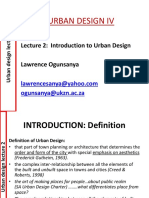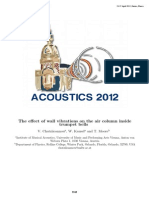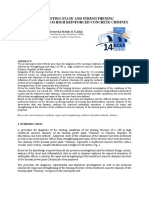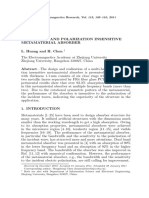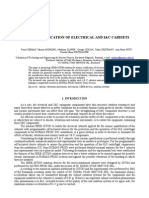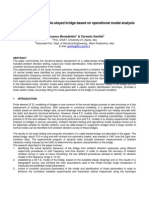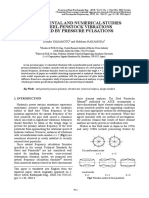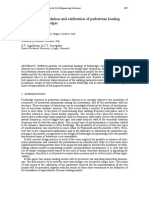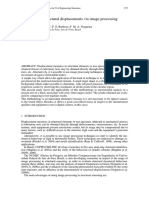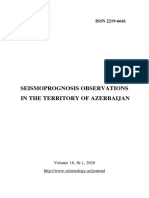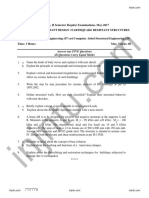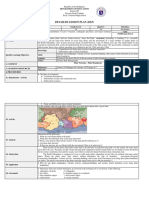CD Paper Pag 337
CD Paper Pag 337
Uploaded by
Anonymous lEBdswQXmxCopyright:
Available Formats
CD Paper Pag 337
CD Paper Pag 337
Uploaded by
Anonymous lEBdswQXmxOriginal Description:
Copyright
Available Formats
Share this document
Did you find this document useful?
Is this content inappropriate?
Copyright:
Available Formats
CD Paper Pag 337
CD Paper Pag 337
Uploaded by
Anonymous lEBdswQXmxCopyright:
Available Formats
Experimental Vibration Analysis for Civil Engineering Structures
337
Comparison of experimental and analytical data for a reinforced
concrete chimney
A.K. Antonopoulos & C.A. Syrmakezis
Institute of Structural Analysis and Aseismic Research, School of Civil Engineering, Athens, Greece
ABSTRACT: This paper presents the comparison of the results, of the experimental measurements of the constructions behavior during an actual dynamic excitation and the results of time
and frequency domain analysis of the models construction behavior by using finite element
method in a real reinforced concrete chimney 135.00 meters high.
1 INTRODUCTION
Chimneys used in the past or even those being used currently in the industry, had to be designed
elastically even for large seismic forces. The most usual materials for chimneys are concrete,
steel and brick, combined with different insulation and lining materials. These structures are
usually high and the appropriate size for each chimney is mainly selected to satisfy the draught
requirements of the boilers and the needs of the industrial processes (Pinfold, 1984).
These structures can have different forms, simple prismatic and truncated cone cantilevers, as
shown in Figure 1. Chimneys are continuous systems because mass and stiffness are distributed.
The response of a continuous system is given by the solution of the governing differential equations, which must satisfy certain prescribed boundary conditions of the system domain.
Figure 1. Main types of chimneys forms.
For these types of structures dynamic analysis is used, where superior eigenmodes are taken
into consideration to calculate the total amount of the structural response under an actual dynamic excitation. Such an analysis has to take into consideration the effects of the bending and
shear deformation, the soil-structure interaction, the effect of the rotational inertia and the effect
of insulation in the total damping coefficient of structure.
A recording process concerning the excitations as well as the response of the structure is applied first for a long period of time by using tri-axial acceleration sensors and vibration record-
338
EVACES07
ers on selected points. Both the tri-axial acceleration sensors as well as the vibration recorders
are monitored by network controllers. The processing of the results using analysis in frequency
domain is followed by the calculation of the structures dynamic characteristics, such as eigenfrequencies and eigenperiods. The damping coefficient of the structure is defined through the
displacement or acceleration measurements u1 and u1+j or 1 and 1+j, respectively, among j successive vibrations measurements from an impulsive excitation.
At the next step, the structure is discretized using a finite element mesh of three-dimensional
solid elements which reproduces satisfactorily the actual structures properties in an adequately
reliable way. The chimneys behavior is examined using time and frequency domain analysis
under an actual dynamic excitation. This process leads to the calculation of the dynamic excitations frequencies and therefore of those that cause the most unfavorable excitations.
2 DESCRIPTION OF THE STRUCTURE
A reinforced concrete chimney 135 meters high is situated in the major area of Piraeus harbor,
Greece. It was built in 1976, by a Greek industry to serve factory of fertilizers. The chimney
was in use at least for twenty years, until the closure of the factory. Nowadays the factorys area
and its surrounded are being rehabilitated. The chimney actual state is illustrated in Figure 2.
Figure 2. A reinforced concrete chimney, in Piraeus, Greece.
According to the structures drawings, found among the general files of the factory records,
the chimney considered has the form of a truncated cone shell, internal diameter of 6.40 m at the
base and of 2.90 m at the top. The thickness of shell at the base is 0.60 m and at the top is 0.20
m. The chimneys thickness and diameter are varying linearly along the structures height. As
shown in Figure 3, the interior of the shell consists of the following successive layers: 0.35 m of
glassfibre and 0.12 m of acid - resisting brick. Between these two layers of insulation and the
outer reinforced concrete shell there is a gap of 0.60 m.
The chimneys foundation is constituted by two parts of massive reinforced concrete, one of
cylindrical shape and one of truncated cone shape. The first (lower) part has a diameter of 20.00
m and is 1.60 m high. The second (higher) part has a maximum diameter of 20.00 m, a minimum of 3.00 m and is 1.40 m high.
339
Experimental Vibration Analysis for Civil Engineering Structures
Reinforced Concrete
Gap
Glassfibre
Acid-resisting Brick
0.12
0.35 0.60
0.60
Figure 3. Detailed view of this section.
3 EXPERIMENTAL MEASUREMENTS
Tri-axial acceleration sensors and vibration recorders are installed at the mid height of the chimney and are exposed to an ambient and an impulsive excitation for a long period of time. Parameter settings trigger level to each direction, the pre-event and post-event time, and the sampling rate are applied in the vibration recorders.
Figure 4 shows a typical record of an ambient vibration of one of the two horizontal directions, which is caused by a natural wind of the area. Although the vibration level is very low
below perception threshold the signal can be measured and the eigenfrequency can be accurately determined (Syrmakezis 2005).
The analysis in frequency domain gives an additional possibility to improve the determination of the eigenfrequencies. From the amplitude spectra, as shown in Figure 5, the engenfrequencies of the structure are obtained, it provides clearly the representation of the frequency
content of the forcing function and the frequencies whose influence on the structure is the most
intense (Bracewell 2000).
Acceleration (mm/s2)
3.00
2.00
1.00
0.00
-1.00
-2.00
-3.00
0
Time (sec)
Figure 4. Ambient vibration of the structure.
10
Displacement (mm)
340
EVACES07
0.0005
0.0005
0.0004
0.0004
0.0003
0.0003
0.0002
0.0002
0.0001
0.0001
0.0000
00
20
2
40
4
606
80
8
100
10
Frequency (Hz)
Figure 5. Amplitude spectra of ambient vibration of the structure.
Impulsive excitation is a convenient way to determine the eigenfrequencies and damping of a
structure. Figure 6 shows a record of impulsive vibrations which are caused by the Schmidt
concrete test hammer during non-destructive testing.
The analysis in frequency domain gives an additional possibility to improve the determination of the eigenfrequencies. From the amplitude spectra, as shown in Figure 7, the engenfrequencies of the structure are obtained.
The damping ratio it is not possible to determine analytically for practical structures, this
elusive property should be determined experimentally. Free vibration experiments provide one
means of determining the damping. Over j cycles the motion decreases from u1 to uj+1. This ratio
is given by equation 1 (Chopra 2001).
The experiments in chimney model led to the free vibration records presented in Figure 8,
which is the same with Figure 6 but for a different scale and period of time. For damped systems the damping ratio can be determined from equation 1.
u uj
ui
u u u
= 1 2 3 ... 3
= e j
u j+1 u 2 u 3 u 4 u 4 u j+1
(1)
= (1 j) ln ( u1 u j+1 ) 2
(2)
The experiments in chimney model led to the free vibration records presented in Figure 8,
which is the same with Figure 6 but for a different scale and period of time. For damped systems the damping ratio can be determined from equation 3 (Chopra 2001).
=
u
1
ln i
2j u i+j
or
&&
u
1
ln i
2j &&
u i+j
(3)
The first of these equations is equivalent to Equation 1. The second is a similar equation in
terms of accelerations, easier to measure than displacements.
The damping coefficient of the structure is defined through the acceleration measurements 1
and 1+j among j successive vibrations and has the value of 1.5%, as shown in Figure 8.
The natural period T of the system can also be determined from the free vibration record by
measuring the time required to complete one cycle of vibration. Comparison with the natural period obtained from the calculated stiffness and mass of an idealized system shows that these
properties were calculated accurately and the idealization representing the actual structure is satisfactory.
341
Experimental Vibration Analysis for Civil Engineering Structures
Acceleration (mm/s2)
30.00
20.00
10.00
0.00
-10.00
-20.00
-30.00
0
10
80
8
100
10
Time (sec)
Figure 6. Impulse vibration of the structure.
0.0004
Displacement (mm)
0.0004
0.0003
0.0003
0.0002
0.0002
0.0001
0.0001
0.0000
0
20
2
40
60
4
6
Frequency (Hz)
Figure 7. Amplitude spectra of impulse vibration of the structure.
Acceleration (mm/s2)
30.00
20.00
=1.5%
10.00
0.00
-10.00
-20.00
-30.00
14
14.2
14.4
14.6
Time (sec)
Figure 8. Impulse vibration of the structure.
14.8
15
342
EVACES07
4 ANALYTICAL RESULTS
At a next step the structure is discretized using a finite element mesh of three-dimensional solid
elements which reproduces satisfactorily the actual structures properties in an adequately reliable way (Zienkiewicz & Taylor 1987). Taking into consideration the soil-structure interaction,
the elastic half-space is discretized using three-dimensional solid elements is shown in Figure 9.
Each node of finite elements activates three degrees of freedom, but the nodes on the circumferences of the cycle that defines the elastic half-space are constrained against horizontal translations and all the nodes at the base of the elastic half-space are considered to be constrained
against horizontal and vertical translations.
The assumed moduli of elasticity and poisson ratio of the chimney and the ground are E=32
GPa, n=0.2 and E=10 GPa, n=0.3 respectively.
2008
2007
2006
2005
2004
2003
2001
2002
Figure 9. The model of the structure.
The loads of glassfibre and acid - resisting brick have been taken into account as concentrated
masses at the nodes of the finite elements.
The eigenfrequencies were calculated through a procedure of successive parametric and probabilistic solutions. The necessity of this procedure lies on the existence of various uncertainties
that have to be taken into consideration these uncertainties are related to the geometry of the
structure, the modulus of elasticity (varies along the height), the damping coefficient, the effect
of the insulation and the poisson ratio (Antonopoulos 2005, Antonopoulos & Syrmakezis 2006).
The successive solutions reveal the extent of the influence of each parameter on the frequency of the structure. This process leads to the calculation of the dynamic excitations frequencies.
343
Experimental Vibration Analysis for Civil Engineering Structures
Table 1. Frequency of the model of the structure
Structures Modulus
Cases
of Elasticity (GPa)
32
Without insulation
34
36
32
With insulation
34
36
Table 2. Frequency of the model of the structure
Soils Characteristics
Cases
E (GPa)
1
Structures Modulus
of Elasticity 32GPa,
5
n=0.2
10
Frequency (Hz)
0.42
0.43
0.45
0.33
0.34
0.35
1.61
1.63
1.69
1.27
1.31
1.35
3.84
3.86
3.98
3.03
3.13
3.23
7.13
7.14
7.24
5.55
5,64
5.88
Frequency (Hz)
0.33
0.33
0.33
1.24
1.26
1.27
2.92
2.94
3.03
4.36
5.44
5.55
Table 3. Comparison between the measurement and analytical dynamic characteristics
Cases
Frequency (Hz)
F.E Model
0.42
1.61
3.84
7.13
Without insulation
F.E Model
0.33
1.27
3.03
5.55
With insulation
Measurement
0.41
1.55
3.71
7.08
Ambient excitation
Measurement
0.50
1.73
3.95
7.24
Impulse excitation
Table 1 shows the effects of insulation on the first four eigenfrequencies of the structure for a
variety of concretes moduli of elasticity and Table 3 shows the comparison of experimental and
analytical results for the first four eigenfrequencies of the structure.
Below, the chimneys behavior is examined using time and frequency domain analysis for the
1999 earthquake of Athens; Figure 10 depicts the ground motion recorded during this earthquake (Chopra 2001, Humar 2002).
Figure 11 is created using the Fast Fourier Transform and shows the amplitude of the acceleration for each one of the excitation frequencies. Using the amplitude spectrum are determined
those frequencies which influence most unfavorably the excitation of the structure. Figure 12
depicts the signal power of each frequency of the signal (acceleration).
Figure 13 shows the acceleration response spectrum for the 1999 earthquake of Athens
ground motion for various damping coefficients (=1%, 3%, 5%).
Acceleration (m/sec2)
3.0
2.0
1.0
0.0
-1.0
10
20
30
40
-2.0
-3.0
Time (sec)
Figure 10. Acceleration recorded during the 1999 earthquake of Athens.
344
EVACES07
Acceleration (m/s2)
0.05
0.04
0.03
0.02
0.01
0
0.0
10.0
20.0
Frequency (Hz)
30.0
40.0
Figure 11. Amplitude spectrum for the 1999 earthquake of Athens ground motion.
Acceleration (m/s2)
0.04
0.03
0.02
0.01
0
0.0
10.0
20.0
Frequency (Hz)
30.0
40.0
Figure 12. Power spectrum for the 1999 earthquake of Athens ground motion.
Acceleration (m/sec2)
10.00
8.00
6.00
4.00
2.00
0.00
0.0
0.5
1.0
Time (sec)
1.5
2.0
Figure 13. Acceleration response spectrum for the 1999 earthquake of Athens ground motion for various
damping coefficients (=1%, 3%, 5%).
345
Experimental Vibration Analysis for Civil Engineering Structures
Displacement (m)
0.2
0.1
0
-0.1
-0.2
0
4
6
Time (sec)
10
Figure 14. Displacement Response at the top of the structure for =1%, 3%, 5% damping coefficients.
Figure 14 shows the displacement response at the top of the structure for various damping
coefficients (=1%, 3%, 5%). The changes of the response prove the major importance of the
damping coefficient. It is quite clear that when it comes to existing structures, it is vital to confirm the analytical data concerning the damping coefficient with experimental measurements in
order to minimize the uncertainties included and the possibility of fatal errors as well.
5 CONCLUSIONS
In this paper the experimental measurements of the chimney and the dynamic analysis in the
time and frequency domain have been presented and compared.
The processing of the results using analysis in frequency domain is followed by the calculation of the structures dynamic characteristics, such as eigenfrequencies and eigenperiods. Comparative calculation of the frequencies of the structure for the two different dynamic excitations
took place. Ambient excitation is caused by wind forces and impulse excitations are caused by
Schmidt hammer impact at the bottom of the structure.
The damping coefficient of the structure is defined through the displacement or acceleration
measurements u1 and u1+j or 1 and 1+j, respectively, among j successive vibrations measurements from an impulsive excitation. The impulse excitations produce a diminishing response,
because their influence is not continuous like the winds, and therefore allow the calculation of
the damping coefficient of the structure.
Using a three dimensional mesh of finite elements, the chimney was discretized, and the eigenfrequencies were calculated through a procedure of successive parametric and probabilistic
solutions. The necessity of this procedure lies on the existence of various uncertainties that need
to be taken into consideration. These uncertainties are related to the geometry of the structure,
the modulus of elasticity (varies along the height), the damping coefficient, the effect of the insulation and the poisson ratio. The successive solutions reveal the extent of the influence of each
parameter on the frequency of the structure. This process leads to the calculation of the dynamic
excitations frequencies.
The aim of the frequency domain analysis is to determine the frequencies of the signal which
cause the most unfavorable excitations to the structure. In this paper the accelerogram which
provided the signal is the one of the 1999 earthquake of Athens. The frequency and power spectra are determined with the help of the Fast Fourier Transform.
The acceleration response spectrum derives as well from the accelerogram of the 1999 earthquake of Athens and is presented for a variety of damping coefficients.
346
EVACES07
The need for a realistic identification of the structure and error limitation is very important.
Therefore results of both experimental and analytical methods as well as their comparison
should be performed before any intervention measures are taken.
REFERENCES
Antonopoulos, A.K. 2005. Comparative Explorations of Analysis Methods for the Dynamic Behavior of
Structure with Continuously Contributed Mass and Stiffness. Master Thesis.
Antonopoulos, A.K. & Syrmakezis, C.A. 2006. Dynamic Behaviour of Castellated Reinforced Concrete
Structures with Continuously Distributed Mass and Stiffness: Comparative Exploration Design Methods. Sixteenth Greek Conference on Reinforced Concrete Structure. Volume 4. Pages: 3-14.
Bracewell, N.R. 2000. Fourier Transform and its Applications. New York: McGraw-Hill Companies.
Chopra, A.K. 2001. Dynamics of Structures. New Jersey: Prentice Hall.
Humar, J.L. 2002. Dynamics of Structures. Tokyo: Balkema Publisher Lisse.
Syrmakezis C.A. 2005. Seismic Protection of Historical Structures and Monuments. Structural Control
and Health Monitoring. Volume 13. Issue 6. Special Issue: Third European Conference on Structural
Control. Pages: 958-979.
Pinfold, G.M. 1984. Reinforced Concrete Chimneys and Towers. London: Palladian Publications LTD.
Zienkiewicz, O.C. & Taylor, R.L. 1987. The finite Element Method, Basic Formulation and Linear Problems. London: McGraw-Hill Book Company.
You might also like
- ME7360 Assignment 1 PDFDocument3 pagesME7360 Assignment 1 PDFVivek V ShetNo ratings yet
- 07a72101-Vibrations and Structural DynamicsDocument8 pages07a72101-Vibrations and Structural Dynamicspoornima reddyNo ratings yet
- Grade 10 Science Activity - Sheets - Earth Science - Plate TectonicsDocument8 pagesGrade 10 Science Activity - Sheets - Earth Science - Plate Tectonicscalix riparip100% (2)
- PhET Plate Tectonics - 2013Document2 pagesPhET Plate Tectonics - 2013CloudKielGuiangNo ratings yet
- Structural Design Questions and AnswersDocument24 pagesStructural Design Questions and AnswersJohn Kervin Rodriguez50% (2)
- Lecture 2 Introduction To Urban Design PDFDocument27 pagesLecture 2 Introduction To Urban Design PDFMelodia Chavez100% (1)
- Experimental Determination of Dynamic Characteristics of StructuresDocument9 pagesExperimental Determination of Dynamic Characteristics of StructuresCristian GhindeaNo ratings yet
- 2012 The Effect of Wall Vibrations On The Air Column Inside Trumpet Bells PDFDocument6 pages2012 The Effect of Wall Vibrations On The Air Column Inside Trumpet Bells PDFtitov33No ratings yet
- B.W. CONEM - 2018 (Final)Document4 pagesB.W. CONEM - 2018 (Final)Guilherme PradoNo ratings yet
- Modal Parameters of A RC Frame Structure Identified From Ambient Vibration MeasurementsDocument10 pagesModal Parameters of A RC Frame Structure Identified From Ambient Vibration MeasurementsCristi AndoneNo ratings yet
- Development of Three-Dimensional Seismic Isolation Systems For Fast Reactor ApplicationDocument6 pagesDevelopment of Three-Dimensional Seismic Isolation Systems For Fast Reactor Applicationrmm99rmm99No ratings yet
- Seismic Analysis of Electronic Cabinet Using ANSYSDocument8 pagesSeismic Analysis of Electronic Cabinet Using ANSYSkrisbhaskarNo ratings yet
- (2009) Some - Aspects - of - The - Dinamic - Cross - Wind - Response - of - Tall - Industrial - ChimneyDocument21 pages(2009) Some - Aspects - of - The - Dinamic - Cross - Wind - Response - of - Tall - Industrial - ChimneyHugo Hernandez BarriosNo ratings yet
- FRP Strengthening ChimneyDocument9 pagesFRP Strengthening ChimneyaygunbayramNo ratings yet
- De Paola 2018 J. Phys. Conf. Ser. 1110 012004Document10 pagesDe Paola 2018 J. Phys. Conf. Ser. 1110 012004teorikdeliNo ratings yet
- Correlation of Different Strong Motion Duration Parameters and Damage Indicators of Reinforced Concrete StructuresDocument6 pagesCorrelation of Different Strong Motion Duration Parameters and Damage Indicators of Reinforced Concrete Structuresryan rakhmat setiadiNo ratings yet
- Mohammad Rakibul Islam Khan, Zafrul Hakim Khan, Mohammad Fahim Raiyan and Khan Mahmud AmanatDocument14 pagesMohammad Rakibul Islam Khan, Zafrul Hakim Khan, Mohammad Fahim Raiyan and Khan Mahmud AmanatShoyeeb AhmedNo ratings yet
- Non Destructive Testing of Concrete StructuresDocument24 pagesNon Destructive Testing of Concrete StructuresThe Engineers EDGE, Coimbatore100% (1)
- Vibration Analysis of Deployable StructuresDocument20 pagesVibration Analysis of Deployable StructuresAdarsh AddyNo ratings yet
- Experimental Study of Base Isolation System For Small Equipments and Its EvaluationDocument8 pagesExperimental Study of Base Isolation System For Small Equipments and Its EvaluationShakeel RanaNo ratings yet
- CAPITOLUL 3 - Engl.Document26 pagesCAPITOLUL 3 - Engl.structuralcalculationsNo ratings yet
- Viscoelastic Damping For Wind-Excited Motion of A Five-Story Building FrameDocument13 pagesViscoelastic Damping For Wind-Excited Motion of A Five-Story Building FrameSophie ClerkeNo ratings yet
- Erformance Valuation of Einforced Concrete Frame Subjected To Pulse ExcitationsDocument9 pagesErformance Valuation of Einforced Concrete Frame Subjected To Pulse ExcitationsBabak Esmailzadeh HakimiNo ratings yet
- Damping Characteristics of Rivetted BeamDocument7 pagesDamping Characteristics of Rivetted BeamIJSTENo ratings yet
- Progress in Electromagnetics Research, Vol. 113, 103-110, 2011Document8 pagesProgress in Electromagnetics Research, Vol. 113, 103-110, 2011Rasheduzzaman SifatNo ratings yet
- CD Paper Pag 295Document12 pagesCD Paper Pag 295Anonymous lEBdswQXmxNo ratings yet
- 2006 - N Murota - Earthquakesimulatortestingofbaseisolatedpowertrans (Retrieved 2016-11-23)Document9 pages2006 - N Murota - Earthquakesimulatortestingofbaseisolatedpowertrans (Retrieved 2016-11-23)emilioaraNo ratings yet
- Fiber Bragg CFR PDocument7 pagesFiber Bragg CFR PAswin HaridasNo ratings yet
- Design Wind Loads On Reinforced Concrete ChimneyDocument6 pagesDesign Wind Loads On Reinforced Concrete ChimneyeshanganjuNo ratings yet
- Seismic Calification of Electrical and I&c CabinetsDocument6 pagesSeismic Calification of Electrical and I&c CabinetsZamfir MadalinaNo ratings yet
- IMAC XXVI Conf s20p03 F.E Modelling Cable Stayed Bridge Based Operational Modal AnalysisDocument10 pagesIMAC XXVI Conf s20p03 F.E Modelling Cable Stayed Bridge Based Operational Modal AnalysisPercy Arana PumaNo ratings yet
- Experimental Analysis of Earthquake Shake TableDocument4 pagesExperimental Analysis of Earthquake Shake TableAJER JOURNALNo ratings yet
- Experimental Analysis of Earthquake Shake TableDocument4 pagesExperimental Analysis of Earthquake Shake TableAJER JOURNALNo ratings yet
- Testing Concrete StructuresDocument51 pagesTesting Concrete Structuresmusiomi2005No ratings yet
- Design and Simulation of MEMS-based Dual-Axis Uidic Angular Velocity SensorDocument6 pagesDesign and Simulation of MEMS-based Dual-Axis Uidic Angular Velocity SensorRahul ParkNo ratings yet
- Analysis of Nonlinear Vibro-Acoustic Wave Modulations Used For Impact Damage Detection in Composite StructuresDocument7 pagesAnalysis of Nonlinear Vibro-Acoustic Wave Modulations Used For Impact Damage Detection in Composite StructuresferdincaninNo ratings yet
- ICSAS 2011 SE 03-Rev DTMFDocument6 pagesICSAS 2011 SE 03-Rev DTMFVincenzo PilusoNo ratings yet
- Gas Pipeline Monitoring SystemDocument10 pagesGas Pipeline Monitoring SystemJavierNo ratings yet
- Tangsopha 2017Document4 pagesTangsopha 2017Đăng PhạmNo ratings yet
- 10 Hussien and MutasherDocument23 pages10 Hussien and MutasherFikri RahimNo ratings yet
- Akusticheskaya Neustoychivost V Kamerah S Usrednyonnym Potokom I Vydeleniem TeplaDocument15 pagesAkusticheskaya Neustoychivost V Kamerah S Usrednyonnym Potokom I Vydeleniem Teplaserge.qroffNo ratings yet
- Eng 2010 4 285 296Document12 pagesEng 2010 4 285 296KakaNo ratings yet
- Determination of Hyper Static Moments in Post-Tensioned Concrete Flat SlabDocument5 pagesDetermination of Hyper Static Moments in Post-Tensioned Concrete Flat SlabHedda StoicescuNo ratings yet
- Experimental and Numerical Studies On Steel Penstock Vibrations Caused by Pressure PulsationsDocument12 pagesExperimental and Numerical Studies On Steel Penstock Vibrations Caused by Pressure PulsationsyosaNo ratings yet
- Examination of Reinforced Concrete Beams With Self-Healing Properties by Acoustic Emission AnalysisDocument7 pagesExamination of Reinforced Concrete Beams With Self-Healing Properties by Acoustic Emission Analysisabhijitpadiyachi33No ratings yet
- Helicopter Interior Noise Reduction Using Compounded Periodic StrutsDocument17 pagesHelicopter Interior Noise Reduction Using Compounded Periodic StrutsGuilherme DuarteNo ratings yet
- Chapter 8: Generation of Floor Response Spectra and Multiple Support Excitation G. R. Reddy & R. K. VermaDocument14 pagesChapter 8: Generation of Floor Response Spectra and Multiple Support Excitation G. R. Reddy & R. K. VermaDivya Dev C MNo ratings yet
- Yi-Lei Li Et Al - Measurement On Effective Shear Viscosity Coefficient of Iron Under Shock Compression at 100GPaDocument3 pagesYi-Lei Li Et Al - Measurement On Effective Shear Viscosity Coefficient of Iron Under Shock Compression at 100GPaDeez34PNo ratings yet
- Heat Effects On Dynamic Response of 52m-Steel Chimney Via In-Situ Modal TestingDocument8 pagesHeat Effects On Dynamic Response of 52m-Steel Chimney Via In-Situ Modal Testingkhalid707No ratings yet
- Modeling Thermal Losses in A New CLFR CavityDocument6 pagesModeling Thermal Losses in A New CLFR CavityPedro HortaNo ratings yet
- The Five-Point Bending Test Applied On Wearing Courses Laid On Orthotropic Steel DecksDocument8 pagesThe Five-Point Bending Test Applied On Wearing Courses Laid On Orthotropic Steel DecksEmilioLimberArredondoOyolaNo ratings yet
- Symmetric 3D R/C Buildings Subjected To Bi-Directional Input Ground MotionDocument8 pagesSymmetric 3D R/C Buildings Subjected To Bi-Directional Input Ground MotionPRAVEEN NAUTIYALNo ratings yet
- Oscillations Periodic Random Tuning Fork Reed Woodwind Instrument Harmonica LoudspeakerDocument21 pagesOscillations Periodic Random Tuning Fork Reed Woodwind Instrument Harmonica LoudspeakerneenoonaaNo ratings yet
- Verification of The Wind Response of A Stack Structure: D. Makovička, J. Král, D. MakovičkaDocument7 pagesVerification of The Wind Response of A Stack Structure: D. Makovička, J. Král, D. Makovičkahkd3No ratings yet
- In Situ Deformation Experiments - Technical AspectsDocument11 pagesIn Situ Deformation Experiments - Technical AspectsMevlüt TürközNo ratings yet
- 5.in Simcenter STARDocument9 pages5.in Simcenter STARkather ahmedNo ratings yet
- h2 Physics Data Questions 2012Document27 pagesh2 Physics Data Questions 2012Benjamin TeoNo ratings yet
- Gear Mesh FrequencyDocument8 pagesGear Mesh FrequencyEndang SubarnaNo ratings yet
- Micro - and Nano Systems Based On Vibrating StructuresDocument8 pagesMicro - and Nano Systems Based On Vibrating StructuresjovinjoNo ratings yet
- Civil EngineeringDocument10 pagesCivil EngineeringMudasir HussainNo ratings yet
- Molecular Mechanisms in Materials: Insights from Atomistic Modeling and SimulationFrom EverandMolecular Mechanisms in Materials: Insights from Atomistic Modeling and SimulationNo ratings yet
- CD Paper Pag 363Document10 pagesCD Paper Pag 363Anonymous lEBdswQXmxNo ratings yet
- Eecs 2012 217Document202 pagesEecs 2012 217Anonymous lEBdswQXmxNo ratings yet
- CD Paper Pag 373Document10 pagesCD Paper Pag 373Anonymous lEBdswQXmxNo ratings yet
- CD Paper Pag 295Document12 pagesCD Paper Pag 295Anonymous lEBdswQXmxNo ratings yet
- CD Paper Pag 307Document10 pagesCD Paper Pag 307Anonymous lEBdswQXmxNo ratings yet
- CD Paper Pag 353Document10 pagesCD Paper Pag 353Anonymous lEBdswQXmxNo ratings yet
- CD Paper Pag 285Document10 pagesCD Paper Pag 285Anonymous lEBdswQXmxNo ratings yet
- CD Paper Pag 247Document10 pagesCD Paper Pag 247Anonymous lEBdswQXmxNo ratings yet
- CD Paper Pag 227Document10 pagesCD Paper Pag 227Anonymous lEBdswQXmxNo ratings yet
- CD Paper Pag 277Document8 pagesCD Paper Pag 277Anonymous lEBdswQXmxNo ratings yet
- CD Paper Pag 199Document10 pagesCD Paper Pag 199Anonymous lEBdswQXmxNo ratings yet
- CD Paper Pag 189Document10 pagesCD Paper Pag 189Anonymous lEBdswQXmxNo ratings yet
- CD Paper Pag 179Document10 pagesCD Paper Pag 179Anonymous lEBdswQXmxNo ratings yet
- CD Paper Pag 113Document10 pagesCD Paper Pag 113Anonymous lEBdswQXmxNo ratings yet
- Nathan World Map of Natural HazardsDocument7 pagesNathan World Map of Natural HazardsYCNo ratings yet
- Seismoprognosis Observations in The Territory of Azerbaijan: ISSN 2219-6641Document52 pagesSeismoprognosis Observations in The Territory of Azerbaijan: ISSN 2219-6641spamscgNo ratings yet
- 31 Guideline - For - Cyclone - Resistant - Construction - of - Building PDFDocument29 pages31 Guideline - For - Cyclone - Resistant - Construction - of - Building PDFDepanshu GolaNo ratings yet
- Seismic Site ResponseDocument70 pagesSeismic Site ResponseHuyTqNo ratings yet
- 1626 Earthquake Resistant Struct PDFDocument1 page1626 Earthquake Resistant Struct PDFSagarNo ratings yet
- Concept Attainment Lesson Plan PDF Standard 8Document4 pagesConcept Attainment Lesson Plan PDF Standard 8Haley50% (4)
- Banks-Leite Et Al 2014 - 0Document6 pagesBanks-Leite Et Al 2014 - 0Amanda AlvesNo ratings yet
- Biggy BigDocument14 pagesBiggy BigDaffa FirmansyahNo ratings yet
- Intra MurosDocument4 pagesIntra MurosAngelica ArevaloNo ratings yet
- Comparative Study On RC Frame Displacement Due To Earthquake Force Based On BNBC 2006 & BNBC 2015Document21 pagesComparative Study On RC Frame Displacement Due To Earthquake Force Based On BNBC 2006 & BNBC 2015Md Rashedul IslamNo ratings yet
- Meera BaiDocument8 pagesMeera BaiSunil Shekhar NayakNo ratings yet
- Design Manual For Permanent Ground Anchor Walls Lib2967Document268 pagesDesign Manual For Permanent Ground Anchor Walls Lib2967Tudor CostescuNo ratings yet
- Detailed Lesson Plan (DLP) : Knowledge Skills Attitudes ValuesDocument7 pagesDetailed Lesson Plan (DLP) : Knowledge Skills Attitudes ValuesAndrie Vonn Perocho NerpiolNo ratings yet
- Philippine Geography, Climate and ArchitectureDocument13 pagesPhilippine Geography, Climate and ArchitectureJohn BulloughNo ratings yet
- S8 - Q2 - Week 1Document11 pagesS8 - Q2 - Week 1Dabe Genesis Ligalig100% (1)
- PLAXIS Ground Response AnalysisDocument46 pagesPLAXIS Ground Response AnalysisAnonymous D5s00DdU100% (1)
- Performance-Based Approach in Seismic Design of Embedded Retaining WallsDocument4 pagesPerformance-Based Approach in Seismic Design of Embedded Retaining WallsBajocarNo ratings yet
- Mecánica de Suelos - ExamplesDocument13 pagesMecánica de Suelos - ExamplesHarold MantillaNo ratings yet
- 23-2 Design of Floor Diaphragms MoroderDocument9 pages23-2 Design of Floor Diaphragms Morodersbarwal9No ratings yet
- DHARAHARA CriticsDocument3 pagesDHARAHARA CriticsAnushka KhatriNo ratings yet
- Senior Project - B+G+7 - GeotecDocument162 pagesSenior Project - B+G+7 - Geotecyeshi janexoNo ratings yet
- Họ và tên thí sinh: ............................................................................... Số báo danh:...........................Document5 pagesHọ và tên thí sinh: ............................................................................... Số báo danh:...........................Mai Anh Thịnh VượngNo ratings yet
- Volcanoes in The World - 6928007 - 2022 - 08 - 22 - 03 - 51Document5 pagesVolcanoes in The World - 6928007 - 2022 - 08 - 22 - 03 - 51Suraj MallahNo ratings yet
- LP - Earthquake HazardsDocument2 pagesLP - Earthquake HazardsMaria Elaine RamosNo ratings yet
- Managing MurphyDocument432 pagesManaging MurphyRayaseelanNo ratings yet





